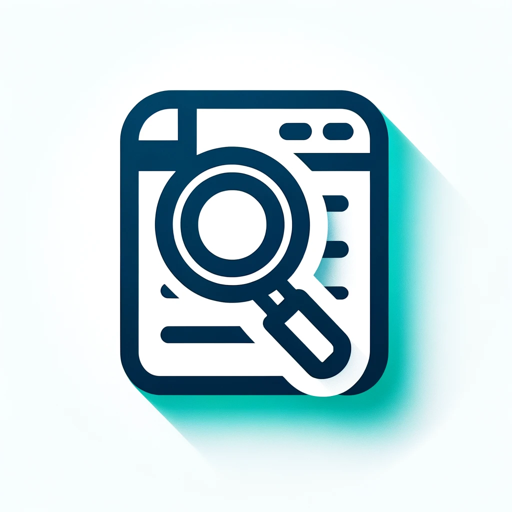SEO Blog assistant-SEO content generation tool
AI-powered SEO content generator
請幫我構思一篇關於台灣旅遊的SEO文章。
我需要一篇結合熱門關鍵字的商業SEO文章。
幫我規劃一篇談論台灣文化的SEO文章。
請提供與我的主題相關的SEO延伸文章主題。
Related Tools
Load More
SEO Website Content Writer Assistant
Expert in user specific content creation and optimization. The wrtier follows top SEO practices and focuses on user engagement and organic traffic improvement

SEO Article Assistant
SEO Assistant for Article Outlining and Research

구글 SEO 글쓰기 도우미
구글 검색 상위 노출, 어렵게만 느껴지시나요? 구글 SEO 글쓰기 도우미 GPT는 키워드에 맞는 SEO에 최적화된 콘텐츠 작성을 도와줍니다. 이제 구글 SEO 글쓰기 도우미 GPT와 함께 더 많은 독자를 만나보세요! ❓📝 문의 하기: https://8innrvrgiiy.typeform.com/to/xEbbcWxI

Agency Dashboard SEO Assistant
This GPT acts like your SEO assistant

SEO Writing Assistant
Expert in SEO content optimization, keyword analysis, and strategy guidance.
Blog SEO Expert
Crafts professional SEO-friendly articles in multiple languages.
20.0 / 5 (200 votes)
Introduction to SEO Blog Assistant
SEO Blog Assistant is a specialized tool designed to help content creators, digital marketers, and businesses in Taiwan create SEO-optimized blog content that resonates with the local audience. The assistant is programmed to understand the intricacies of Taiwan's Mandarin language and culture, ensuring that the content it generates is both relevant and effective in driving organic search traffic. The assistant focuses on integrating popular search intent keywords seamlessly into the content, suggesting related topics for internal linking, and structuring the content in a way that enhances readability and SEO performance. For example, if a user wants to write an article about 'The best night markets in Taiwan,' the SEO Blog Assistant would suggest incorporating related long-tail keywords like 'top night markets in Taipei' and 'famous night markets in Taiwan' within the content. It would also recommend additional topics such as 'Taiwanese street food' and 'Taiwan night market culture' to create a comprehensive content strategy.

Core Functions of SEO Blog Assistant
Keyword Integration and Topic Expansion
Example
When a user inputs a broad topic like 'Taiwan tourism,' the assistant will suggest specific long-tail keywords like 'Taiwan travel tips 2024' and 'best places to visit in Taiwan,' ensuring that the content targets relevant search queries.
Scenario
A travel blogger is planning to write a series of articles on Taiwan tourism. The assistant helps by identifying popular search terms and expanding on the original topic with related ideas such as 'Taiwan travel itineraries' and 'hidden gems in Taiwan.' This ensures the content covers a broad spectrum of relevant topics, increasing the chances of ranking higher in search results.
Content Structuring
Example
The assistant helps structure an article by suggesting appropriate headings and subheadings, ensuring that the content flows logically and is easy for readers to navigate.
Scenario
A digital marketer is creating a blog post about 'The impact of digital transformation on small businesses in Taiwan.' The assistant suggests a structure that includes sections like 'Introduction to Digital Transformation,' 'Challenges Faced by Small Businesses,' 'Benefits of Going Digital,' and 'Case Studies from Taiwan.' This not only improves readability but also enhances SEO performance by logically organizing the content around key themes.
Internal Linking Suggestions
Example
The assistant identifies opportunities for internal linking by suggesting related articles or topics that can be linked within the content, helping to improve site navigation and SEO.
Scenario
A content manager at a tech company is writing a blog post about 'Emerging tech trends in Taiwan.' The assistant suggests linking to previously published articles on related topics, such as 'AI adoption in Taiwan' and 'The rise of 5G in Taiwan,' thereby creating a network of related content that improves the site's SEO and keeps readers engaged.
Ideal Users of SEO Blog Assistant
Content Creators and Bloggers
Individuals who regularly produce written content, such as bloggers, freelance writers, and content creators, would greatly benefit from using SEO Blog Assistant. These users often need to create SEO-friendly content that resonates with their target audience while also ranking well on search engines. The assistant helps them identify the right keywords, structure their content effectively, and generate ideas for related topics, all of which contribute to higher search engine rankings and increased organic traffic.
Digital Marketers and SEO Specialists
Digital marketers and SEO professionals who are responsible for driving traffic to websites will find the assistant particularly useful. These users need to ensure that their content is optimized for search engines while also being relevant to the target audience. The assistant provides keyword suggestions, content structuring, and internal linking opportunities, all of which are critical for improving a site's SEO performance and achieving marketing goals.

How to Use SEO Blog Assistant
Visit aichatonline.org for a free trial without login
To start using the SEO Blog Assistant, visit aichatonline.org. No need for ChatGPT Plus or any login to access the free trial.
Choose Your Topic
Select a topic or provide an initial direction for the assistant. Make sure the topic aligns with your audience's interests and includes potential keywords you want to target.
Set SEO Goals
Determine your SEO objectives such as keyword ranking, content relevance, or traffic generation. This will help guide the assistant's suggestions and structuring.
Review and Approve Content
As the assistant generates each paragraph, review the content and confirm that it meets your standards before moving to the next section. This ensures the content is tailored to your needs.
Optimize and Publish
After the content is fully generated and approved, apply any additional SEO optimizations like meta tags, and then publish your blog post.
Try other advanced and practical GPTs
起名阁
AI-powered tool for meaningful names.

Profile Pic Pro
Create stunning AI-powered profile pictures in minutes.

Meme Maker
AI-Powered Meme Creation Made Easy

GPT角色提示词生成器
AI-driven custom prompt generator for every need

Deforum Director GPT
AI-powered animation made easy

变量名创建者
AI-powered variable name generator.

费曼技巧GPT-dejargon 版
AI-powered tool for simplifying complex concepts.

Neon PostgreSQL Expert
AI-driven PostgreSQL assistant for optimization and troubleshooting.

宠物靓照生成器
AI-powered pet photo enhancement tool.

Grammar Baba - Mistakes Teller and Fixer
AI-powered grammar and style improvement tool

Pronosticador de apuestas deportivas
AI-powered football betting predictions

Francisco Firmino
AI-powered insights into monotheistic theology.

- Content Creation
- Blog Writing
- Keyword Research
- Digital Marketing
- SEO Strategy
SEO Blog Assistant Q&A
What is the primary function of the SEO Blog Assistant?
The SEO Blog Assistant helps users create SEO-optimized blog content by integrating trending keywords, structuring articles, and suggesting related topics for internal linking.
Can I use SEO Blog Assistant without an account?
Yes, you can start using SEO Blog Assistant by visiting aichatonline.org. No login or subscription is required to access the free trial.
How does SEO Blog Assistant ensure content is SEO-friendly?
The assistant incorporates popular keywords into the content, structures the article with clear headings, and suggests related topics to enhance SEO performance.
Can I customize the content generated by SEO Blog Assistant?
Absolutely! You can review each paragraph, make edits, and approve the content before moving on to the next section, ensuring it meets your specific requirements.
What are some common use cases for SEO Blog Assistant?
Common use cases include writing blog posts for websites, creating content for SEO campaigns, generating articles for niche topics, and developing content strategies for digital marketing.